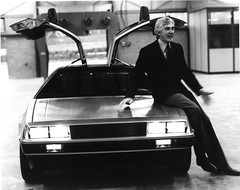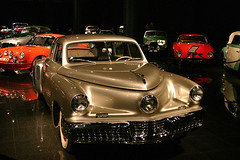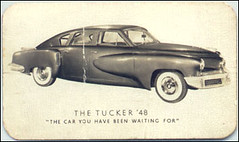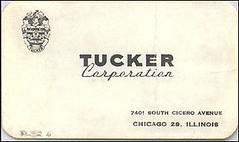Our Milestone Monday feature today will look at a couple of innovators in the Automobile Indusrtry. Preston Tucker and John Zachary De Lorean were not just slightly ahead of their time -- they anticipated automotive design features that would become commonplace five decades later.
In 1938 Norman Bel Geddes was envisioning the roads of the future for the New York World's Fair. In 1948 Preston Tucker built the car for them. A racing enthusiast from his youth, Tucker had contributed to the war effort by building an extremely fast armored combat car. The Army rejected it but the Navy was fascinated with the car's power operated gun turret. The Tucker Turret was used on PT boats, landingcraft and the B-17 and B-29 bombers.After the war, Tucker purchased a large factory in Chicago, the Chicago Dodge Plant, with the intention of building a modern automobile. The Tucker Torpedo incorporated many features that were to become commonplace in automobiles a half-century later. The car had three front headlights and the center light was connected to the steering linkage to track the car's turning. BMW would later re-introduce this tracking feature on their cars. Tuckers also were designed to use fuel injection, disc brakes, a rear engine,cone-of-vision instrument placement and a padded dashboard. The aerodynamic styling was but one of the many innovations Tucker borrowed from aviation technology.
Like today's Prius, the car was beyond the range of most of the day's shops to service. Tucker made the engine easy to drop and envisioned a 'swap' system to allow proper servicing. To raise capital, Tucker pre-sold accessories for the planned car. This creative financing, and the fact that he did not install a lot of automation led United States Attorney Otto Kerner to seek a fraud indictment against Tucker. The charge was made that Tucker never intended to actually produce a car! In 1948 some 37 cars were actually built in a prototype fashion. The entire production of Tuckers would consist of fifty cars!
The trial bankrupted the company and shuttered the factory, but when it went to the jury in 1950 Tucker and his executives were quickly and clearly acquitted. Otto Kerner, who had so aggressively dogged Tucker on fraud charges, would become the first Federal apellate judge in history to be imprisoned. The charge -- stock fraud! A 1988 movie was made of Tucker's life: Tucker, The Man and His Dream.

John De Lorean with his distinctive automobile.
John De Lorean was a more recent maverick of the auto industry. His distinctive gull-wing doors were to become automotive legend as well. Unfortunately De Lorean was to have legal troubles as well. De Lorean was an innovator who envisioned monorail systems for the medians of interstate highways among other things.
I've read articles where the author declares these men 'failures' and heartily disagree with that assessment. Both men brought cutting-edge technology to the point of production and, while they may not have benefitted financially, they certainly influenced their respective industries. Risk, by it's very nature, is risky.
Special thanks to the Tucker Club of America website for historical background for this article. This Open Letter from Preston Tucker is well worth reading as well.







No comments:
Post a Comment